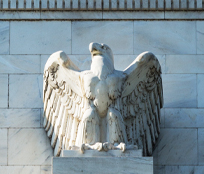The Federal Open Market Committee (FOMC) again left its policy rate unchanged at 4.25% to 4.50%, as was universally expected by Wall Street. The committee’s statement had few changes since the last FOMC meeting in May and reiterated that while uncertainty about the economy has diminished since April, it remains elevated. The difficulty in assessing the size and impact of upcoming fiscal and tariff policy changes is now heightened by the impact that geopolitical conflicts could have on energy prices.
The Summary of Economic Projections (SEP) also generally matched investor expectations. The FOMC members’ rate forecasts—aka the “dot plot”—in total reflect fewer cuts in 2025 and 2026 than previously communicated, though the median dot was unchanged for 2025, and indicate just one cut in 2026. Market-implied pricing shows one to two rate cuts by the end of this year, which mostly has been the case since the May FOMC meeting, and a further two to three cuts next year.
Reflecting the higher effective tariff rate, the median projection shows higher core Personal Consumption Expenditures (PCE) inflation of 3.1% in 2025, lower growth of 1.4% and higher unemployment of 4.5%, which is up a tick from the March forecast. Should these forecasts be met, a trigger of the Sahm Rule would not be threatened. (The Sahm Rule is an economic indicator stating that if the average of the unemployment rate over three months rises a half-percentage point or more above the lowest three-month average over the previous year, then the economy is in a recession.)
Recent inflation trends are encouraging but fragile. Inflation in shelter and other core services continues to slow from the high level of recent years. Although official data has not yet shown widespread increases in goods prices, most at the Federal Reserve (Fed) and in the market still expect these increases to appear in coming months. A potential spike in oil prices due to tensions in the Middle East could also push inflation higher, reversing recent gains.
During the post-meeting press conference, Fed Chair Jerome Powell repeated the FOMC’s preference for patience and the expectation for further clarity emerging over time from the impact of tariffs and other factors related to growth and inflation. The higher rate profile in today’s SEP relative to year-end 2024 reflects the higher 2025 inflation forecast. Powell said he did not think the Fed needs to respond to any concerns of political interference, nor is it considering the Fed Chair succession process.
The full impact of tariffs on inflation and the economy still won’t be seen by the next FOMC meeting at the end of July, so we do not anticipate any policy change at that meeting. However, we do see the interest-rate-sensitive housing and automotive sectors starting to stumble. If inflation increases remain concentrated in imported goods prices and the tentative signs of weakness in the labor market expand, then a rate cut as early as September is possible. Our view is that, in the interim, high-quality fixed-income—particularly with exposure to the intermediate part of the yield curve—continues to offer attractive yields and a compelling risk/return profile.



